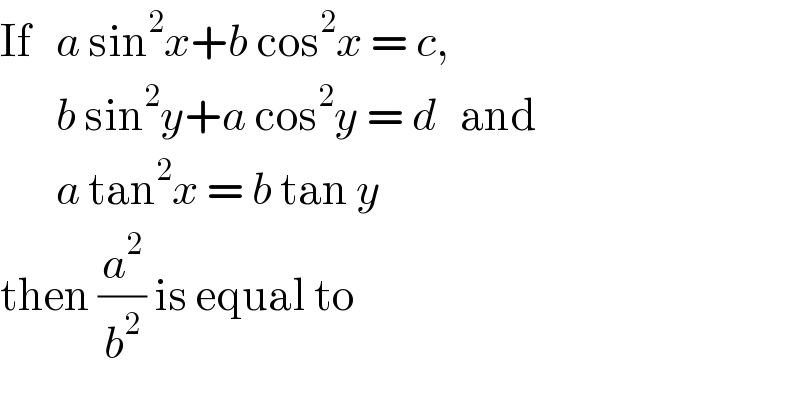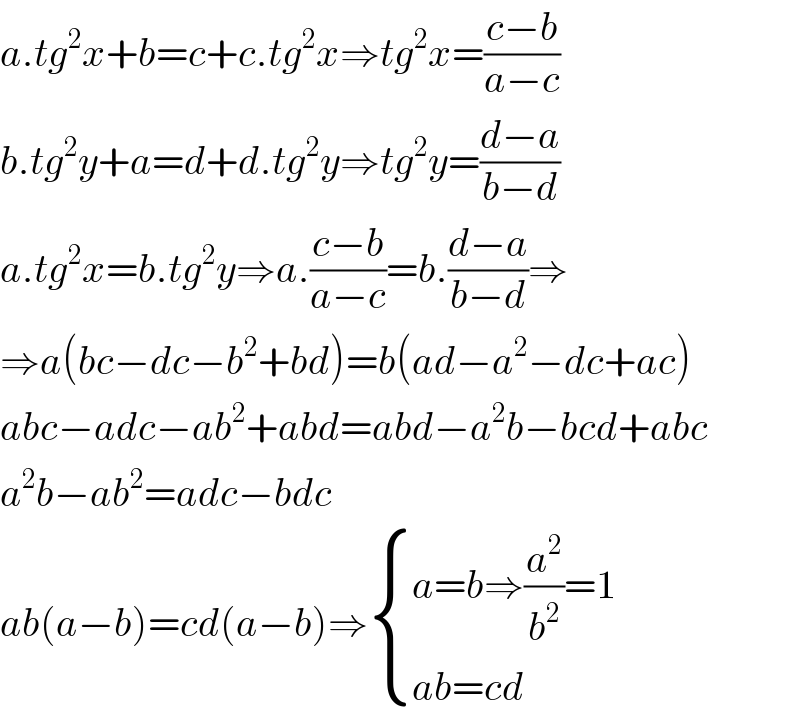Question Number 18702 by Christo01 last updated on 28/Jul/17

$$\mathrm{If}\:\:\:{a}\:\mathrm{sin}^{\mathrm{2}} {x}+{b}\:\mathrm{cos}^{\mathrm{2}} {x}\:=\:{c},\: \\ $$$$\:\:\:\:\:\:\:{b}\:\mathrm{sin}^{\mathrm{2}} {y}+{a}\:\mathrm{cos}^{\mathrm{2}} {y}\:=\:{d}\:\:\:\mathrm{and} \\ $$$$\:\:\:\:\:\:\:{a}\:\mathrm{tan}^{\mathrm{2}} {x}\:=\:{b}\:\mathrm{tan}\:{y}\:\: \\ $$$$\mathrm{then}\:\frac{{a}^{\mathrm{2}} }{{b}^{\mathrm{2}} }\:\mathrm{is}\:\mathrm{equal}\:\mathrm{to} \\ $$
Commented by mondodotto@gmail.com last updated on 29/Jul/17

$$\mathrm{please}\:\mathrm{help}\:\mathrm{me}\:\mathrm{to}\:\mathrm{solve}\:\mathrm{this}\:\mathrm{question} \\ $$
Answered by behi.8.3.4.1.7@gmail.com last updated on 30/Jul/17

$${a}.{tg}^{\mathrm{2}} {x}+{b}={c}+{c}.{tg}^{\mathrm{2}} {x}\Rightarrow{tg}^{\mathrm{2}} {x}=\frac{{c}−{b}}{{a}−{c}} \\ $$$${b}.{tg}^{\mathrm{2}} {y}+{a}={d}+{d}.{tg}^{\mathrm{2}} {y}\Rightarrow{tg}^{\mathrm{2}} {y}=\frac{{d}−{a}}{{b}−{d}} \\ $$$${a}.{tg}^{\mathrm{2}} {x}={b}.{tg}^{\mathrm{2}} {y}\Rightarrow{a}.\frac{{c}−{b}}{{a}−{c}}={b}.\frac{{d}−{a}}{{b}−{d}}\Rightarrow \\ $$$$\Rightarrow{a}\left({bc}−{dc}−{b}^{\mathrm{2}} +{bd}\right)={b}\left({ad}−{a}^{\mathrm{2}} −{dc}+{ac}\right) \\ $$$${abc}−{adc}−{ab}^{\mathrm{2}} +{abd}={abd}−{a}^{\mathrm{2}} {b}−{bcd}+{abc} \\ $$$${a}^{\mathrm{2}} {b}−{ab}^{\mathrm{2}} ={adc}−{bdc} \\ $$$${ab}\left({a}−{b}\right)={cd}\left({a}−{b}\right)\Rightarrow\begin{cases}{{a}={b}\Rightarrow\frac{{a}^{\mathrm{2}} }{{b}^{\mathrm{2}} }=\mathrm{1}}\\{{ab}={cd}}\end{cases} \\ $$
